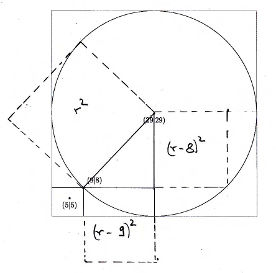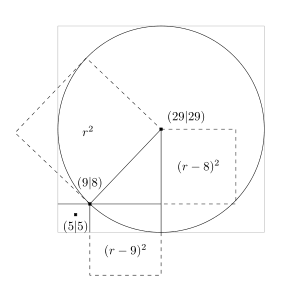|
Ich muss bei der Grafik aus Quadrat mit einbeschrieben Kreis zeichnen nun noch Radien und Quadrate über den Radien einfügen, so dass ersichtlich wird, wie ich auf meine Lösung gekommen bin. Leider scheitere ich schon daran, die Diagonale nur ab den Punkt (9/8) zu zeichnen, vom Rest ganz zu schweigen. \documentclass{article} \usepackage{tikz} \usetikzlibrary{intersections} \usetikzlibrary{through} \usetikzlibrary{decorations.pathmorphing} \usetikzlibrary{decorations.markings} \usetikzlibrary{decorations.pathreplacing,decorations.pathmorphing} \usepgflibrary{decorations.shapes} \usepgflibrary{shapes.geometric} \usetikzlibrary{calc,angles,quotes,babel,decorations.pathreplacing} \usepackage{venndiagram} \usepackage{verbatim} \begin{document} \begin{tikzpicture}[ scale=.2, dot/.style = { draw,fill,inner sep=1pt, label={#1} }] \node[dot={below:$(5|5)$}] at (5,5) {}; \node[dot={above right:$(9|8)$}] at (9,8) {}; \node[dot={below:$(29|29)$}] at (29,29) {}; \node[draw,circle through={(9,8)}] (c) at (29,29) {}; \draw[help lines] (c.west |- c.north) rectangle (c.east |- c.south); \draw (c.west |- 9,8) -- (9,8) -- (c.south -| 9,8); \draw (c.west |- 29,8) -- (29,8) -- (c.south -| 29,8); \draw (c.west |- 9,0) -- (29,29) -- (c.south -| 29,8); \end{tikzpicture} \end{document} So sollte es ausschauen:
|
|
Mit der Antwort aus TikZ: Quadrat über einer Linie wäre dann eine Möglichkeit \documentclass{article} \usepackage{tikz} \usetikzlibrary{through} \usetikzlibrary{calc} \begin{document} \begin{tikzpicture}[ scale=.1, dot/.style = { draw,fill,inner sep=1pt, label={#1} }] \path% mehrmals genutzte Punkte als coordinate speichern (29,29) coordinate (M) (9,8) coordinate (P) (P-|M) coordinate (H)% Schnittpunkt Horizontale durch P und Vertikale durch M ; \node[dot={below:$(5|5)$}] at (5,5) {}; \node[dot={{[label distance=7pt]above:$(9|8)$}}] at (P) {}; \node[dot={above right:$(29|29)$}] at (M) {}; \node[draw,circle through={(P)}] (c) at (M) {}; \draw[help lines] (c.west |- c.north) rectangle (c.east |- c.south); \draw (c.west |- P) -- (P) -- (c.south -| P); \draw (H)--(P)--(M)--(c.south); \draw [dashed]% Quadrate über Linien (P)--($(P)!1!90:(M)$)--($(M)!1!-90:(P)$)coordinate(hpm)--(M) (M)--($(M)!1!90:(H)$)--($(H)!1!-90:(M)$)coordinate(hmh)--(H) (c.south)--($(H)!1!90:(P)$)--($(P)!1!-90:(H)$)coordinate(hhp)--(P|-c.south) ; \path% Beschriftung der Quadrate (P) -- node {$r^2$}(hpm) (M) -- node {$(r-8)^2$}(hmh) (H) -- node [below] {$(r-9)^2$}(hhp) ; \end{tikzpicture} \end{document}
DANKE! Hast du dich vertan mit den Angaben (M) -- node {$(r-9)^2$}(hmh) (H) -- node [below] {$(r-8)^2$}(hhp), ich bin der Meinung es müsste so sein (M) -- node {$(r-8)^2$}(hmh) (H) -- node [below] {$(r-9)^2$}(hhp)? War mir jetzt nicht mehr sicher, sorry.
(20 Jan '16, 17:02)
nixversteh
@nixversteh Ja, die beiden Werte hatte ich versehentlich vertauscht. Hab es jetzt aber korrigiert.
(20 Jan '16, 17:32)
esdd
|



@nixversteh: Der Titel sollte möglichst bereits in der Übersicht einem Hilfesuchenden Hinweise geben, worum es bei dem Problem geht. Etwas wie »noch ein Problem«, »ein weiteres Problem«, »Problem Nummer 4711« ist im Titel nicht sehr sinnvoll. Der Verweis auf die andere Frage wäre dann in der Beschreibung als Link praktischer. Ich habe das in diesem Fall mal gemacht. Außerdem habe ich die Abbildung verkleinert, weil die andere meinen Monitor gesprengt hat.
Die Gerade (Diagonale) durch (29|29) und (9|8) geht weder durch (5|5) noch durch den Ursprung (0|0) - nur ein kleiner Hinweis, weil das mal so stand.
@saputello,
danke dir.
@Mossbrucker,
... das ist auch so korrekt, im ersten thread ist esdd ist von falschen Vorbedingungen ausgegangen.